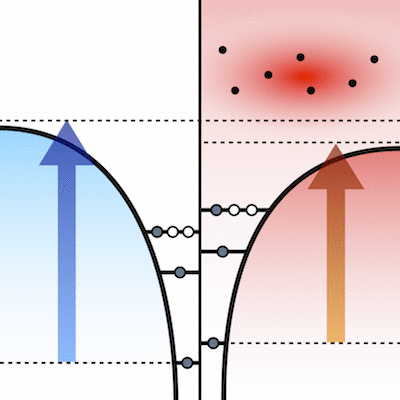
|
 |  |  |  |  |  |  |  |  |  |

Ionization potential depression in dense plasmas
|
The dense plasma state is a common phase of matter in the universe. It can be
found in stars and giant planets, and is created during fusion experiments. The
electronic structure of an atom embedded in a dense plasma differs
significantly from that of an isolated atom.
Due to the screening effect by the charged environment within the plasma,
atomic levels shift and the ionization potential becomes reduced in comparison
with the isolated atomic case, as shown in Figure. This ionization potential
depression (IPD) has so far been described with two distinct theoretical
models: Stewart-Pyatt and Ecker-Kröll. However, their validity has
recently been disputed by two state-of-the-art experiments, one using an x-ray
free-electron laser (LCLS) and the other using a high-power optical laser
(Orion). Neither the Stewart-Pyatt model nor the Ecker-Kröll model could
explain both experiments. This controversy has profound implications for how to
correctly model experiments on dense plasmas.
Here, we present a rigorous and computationally efficient approach to
predicting IPDs: a two-step Hartree-Fock-Slater model. Our approach is based on
first-principle quantum-mechanical calculations for an atom embedded in a dense
plasma, taking into account detailed electronic configurations of plasma ions.
In contrast to the Stewart-Pyatt and Ecker-Kröll models, our two-step
model successfully describes all available experimental data on IPDs.
Calculations within our approach are relatively inexpensive and, therefore, are
expected to be applicable for a wide range of plasma conditions—for
describing data from studies on warm dense matter, planetary science, and
inertial confinement fusion.
[from the website of CFEL-DESY Theory Division]
|

Atomic levels are shifted due to the screening effect by a plasma environment (Left: isolated atom, Right: atom in plasma).
|
Related Publications
- Sang-Kil Son, Robert Thiele, Zoltan Jurek, Beata Ziaja, and Robin Santra, Quantum-mechanical calculation of ionization potential lowering in dense plasmas, Phys. Rev. X 4, 031004 (2014)
![[bib]](/biblio/img/bibtex.gif) [BibTeX] [BibTeX]![[pdf]](/biblio/img/pdf.gif) [pdf] [pdf]![[abstract]](/biblio/img/abstract.gif) [abstract] [abstract]![[link]](/biblio/img/link.gif) doi:10.1103/PhysRevX.4.031004 doi:10.1103/PhysRevX.4.031004
- Robert Thiele, Sang-Kil Son, Beata Ziaja, and Robin Santra, Effect of screening by external charges on the atomic orbitals and photoinduced processes within the Hartree-Fock-Slater atom, Phys. Rev. A 86, 033411 (2012)
![[bib]](/biblio/img/bibtex.gif) [BibTeX] [BibTeX]![[pdf]](/biblio/img/pdf.gif) [pdf] [pdf]![[abstract]](/biblio/img/abstract.gif) [abstract] [abstract]![[link]](/biblio/img/link.gif) doi:10.1103/PhysRevA.86.033411 doi:10.1103/PhysRevA.86.033411
- John Jasper Bekx, Sang-Kil Son, Beata Ziaja, and Robin Santra, Electronic-structure calculations for nonisothermal warm dense matter, Phys. Rev. Res. 2, 033061 (2020)
![[bib]](/biblio/img/bibtex.gif) [BibTeX] [BibTeX]![[pdf]](/biblio/img/pdf.gif) [pdf] [pdf]![[abstract]](/biblio/img/abstract.gif) [abstract] [abstract]![[link]](/biblio/img/link.gif) doi:10.1103/PhysRevResearch.2.033061 doi:10.1103/PhysRevResearch.2.033061
Oral Presentations
Poster Presentations
|  |  |  |  |  |  |  |  |  |  |  | 
Copyright (C) 2000-2025 손상길
저작권에 대한 본 사항이 명시되는 한, 어떠한 정보 매체에 의한
본문의 전재나 발췌도 무상으로 허용됩니다.
[copyleft]
|  |
|